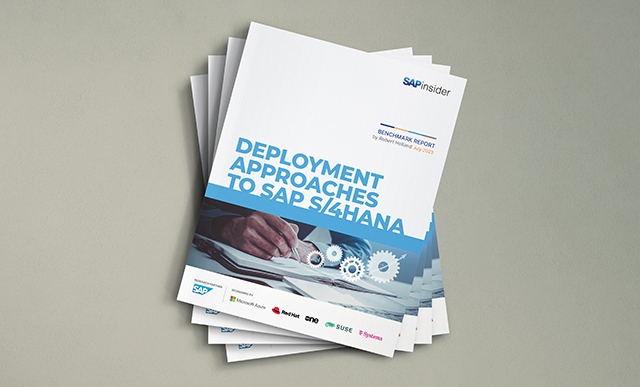5 Key Considerations for an SAP Modernization Project

With support for SAP ECC ending by 2027, enterprises are looking to modernize to SAP S/4HANA, an advanced and powerful enterprise resource planning (ERP) platform built on the SAP in-memory database.
For large enterprises, an SAP migration to cloud project is complex and can take anywhere between 18 to 24 months or more. Hence, examining all potential roadblocks becomes critical. This will help you stay on the projected timeline with minimal business disruption.
Selecting the right technology vendor does provide enterprises with a competitive edge. But the role that the people and process play in the success of a large modernization program cannot be ignored. For example, an SAP S/4HANA migration to cloud requires a significant change to business processes. And enterprises also need to work to drive adoption internally. That’s why it’s important to consider every part of the process and the quality of the data you’re migrating before starting a modernization project.
Putting Data at The Core of Your SAP Modernization
SAP systems store and manage millions of transactional data records to inform various business processes for enterprises. Because data is at the core of any SAP system, enterprises should ensure that their data is fit for use during modernization. This means enterprises must have data sets that can be trusted and leveraged to produce valuable insights. But it’s important to also ask what constitutes trusted data? What are the data challenges organizations should be aware of? And can data issues derail SAP modernization projects or impact the overall cost of modernization?
There are many questions that arise when you are dealing with such a complex SAP transformation. To address these questions, let’s look at five key considerations for enterprises beginning an SAP data migration to cloud project.
1. Choosing a deployment option: Implementing SAP S/4HANA requires participation from multiple stakeholders, depending on the technology layers involved. Enterprises must engage with the right subject matter experts (SMEs) and choose the hosting method that best suits their current SAP landscape.
You have many choices based on your needs when it comes to SAP modernization. These include on-premises and private hosting, public cloud-hosted, partner-managed cloud or a SaaS version of SAP S/4HANA. Companies operating in a very regulated industry may choose a hosting option. On the other hand, companies that don’t have the time and resources to focus on infrastructure management, technical operations and application management may decide to implement a SaaS version.
Moving from on-premises hosting to the SaaS version offers peace of mind as you have fewer issues or key decisions that you need to worry about. However, there may be specific guidelines for each hosting method you need to follow while implementing the new S/4HANA platform. For example, in a SaaS version, you are unable to migrate data or previous settings from legacy ECC systems, forcing you to adopt a “greenfield” implementation.
2. Implementing comprehensive data management: The usability of ERP systems like SAP depends heavily on the data they store. Throughout the modernization, you need several data management tools to ensure data is fit for use when it is migrated to S/4HANA.
For example, simply dumping all of your data to S/4HANA without any data quality checks will only deteriorate the performance of your SAP system. Your business processes require comprehensive and accurate data about certain functions. This includes customer data or financial data. Strategic decisions based on insufficient data will only hamper business operations.
Migrating to SAP S/4HANA requires a conversion from a customer/vendor data model to a more simplified business partner model. This can create a lot of data inconsistencies while building the data pipeline to enable conversion. Also, S/4HANA as a platform requires a high standard of quality for the master data you’re migrating.
That’s why when it comes to SAP modernization, it’s critical to consider a one-stop solution for all your data management needs. It should offer data discovery, data quality monitoring, data enrichment and data mastering across legacy ECC systems.
3. Consolidating ERP systems: Some multi-national organizations have their critical data stored across multiple SAP ECC systems or other legacy ERP systems due to their siloed operating nature or historical mergers and acquisitions. SAP modernization presents an advantageous opportunity for them to consolidate their data across legacy ERP systems, provide their global users with a consistent message and streamline their operations.
These require data integration from multiple legacy platforms to transform the data to a common standard. Then, they need to migrate that data to S/4HANA while making sure that legacy systems are also maintained for the whole modernization period. With the change data capture (CDC) capability, data replication can help automate the migration of all new data coming from legacy systems to the new and modernized SAP system.
Data integration services are also critical to connect the modernized SAP system with other systems. This includes existing or new systems, both within and outside the organization. And it can help ensure a seamless data flow and end-to-end business processes.
4. Democratizing data in S/4HANA: Data scientists, data analysts and line of business leads often need access to enterprise data to fuel their key initiatives. These stakeholders may spend most of their time finding the data they need rather than leveraging required datasets.
Finding the right data can be a complicated and expensive affair if all data requests are forwarded to data engineers. An IT department flooded by individual requests from many stakeholders will not be able to cater to their needs.
Instead, create a common data marketplace and automate the full process of requesting data, managing approval workflows, data provisioning and data delivery. This will enable you to create a data sharing culture and better meet the expectations of your data consumers.
5. Driving adoption of a modernized SAP System: A technology investment is only as good as its adoption. It will not deliver value to you if it is not being used by most of your intended consumers. Let’s consider the two different aspects of S/4HANA adoption. The first is around creating a robust change management strategy. You should provide comprehensive training to all stakeholders to ensure they are proficient in using the new SAP system. A robust change management strategy will facilitate the adoption of a new SAP platform. It will also cater to any resistance from various stakeholders.
You also must focus on the intended use of upgraded systems and work towards addressing any challenges that may have an adverse impact on the expected business outcome. In-memory computing in SAP S/4HANA enables real-time data processing. This allows users to access and analyze real-time data for faster decision-making.
However, a critical parameter to consider is to ensure you have clean and up-to-date data in S/4HANA. Data processing operations based on inconsistent and stale source data degrade its quality. This renders futile and ineffective insights. Having clean and up-to-date data in SAP systems enterprise-wide helps inspire confidence in the insights derived from that data.
Effective data management helps ensure that data is kept up-to-date and synchronized across various modules in S/4HANA. This provides users with accurate and reliable information to make informed decisions. By ensuring data consistency and data integrity, organizations can generate insightful reports and dashboards. This empowers users to gain a deeper understanding of business operations and make decisions faster.
Pay attention to these five key factors to deliver tangible benefits with a successful SAP modernization effort. And here is a bonus tip: focus on automating most of your data management tasks. Leverage augmented data management capabilities to improve the performance of these tools.
Next Steps
For your SAP migration to cloud, the Informatica Intelligent Data Management Cloud (IDMC) provides a one-stop-shop for virtually all the data capabilities an enterprise needs. It brings together data quality, master data management, data integration, data governance and more. Powered by our AI engine, CLAIRE, IDMC offers automation, data intelligence and context to drive efficiency and productivity for SAP modernization projects.





